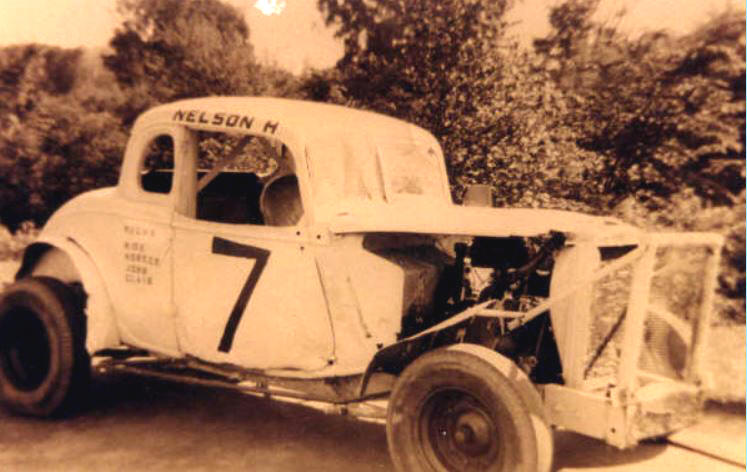
Courtesy of the Midstate Club
The humble coupe of Nelson Harrington, at Midstate Speedway,
illustrates how easily a 7 can be painted on.
BILL'S
[Somewhat] WEEKLY COLUMN/BLOG PAGE
BILL’S BACK IN TIME
By Bill Ladabouche
AND IT STARTED WITH A SIMPLE 7
Many of our recognizable stock car stars seemed to start out in the 1950's with a car numbered 7. It seems like, with most guys [or their wives] doing the lettering jobs in the early days – the car number was either something wild or a simple numeral they could brush on easily. A straight stick #1, the number 7 might be the next easiest one to do.

Courtesy of the Midstate Club
The humble coupe of Nelson
Harrington, at Midstate Speedway,
illustrates how easily a 7 can be painted on.
Depending on what region you might come from, a driver may be someone you've heard of or he could be somewhat of a racing legend. One such man is certainly best known in New England. Moran “Sonny” Rabideau, of Brattleboro, Vermont, probably got his appetite whetted at the local Brattleboro Speedway, which enjoyed a brief life span in West Brattleboro, on Route 9.
It is likely Rabideau began driving with a car connected to his brother. They may have tried tracks like the hometown Brattleboro Speedway, as well as the nearby Hinsdale, NH track [which Brattleboro sort of put out of business]. Then, there was the Safford Park track at the Cheshire Fairgrounds near Keene, NH and the upstart, soon – to – be successful Claremont Speedway on the Fleury farm in Claremont, NH. He may have also run at the Rhythm Inn track in Millers Falls, MA.
Courtesy of Neal Davis
Sonny Rabideau in that ill
– handling first family #7. Below- An improved
version sits on the hauler at Safford Park around 1959.
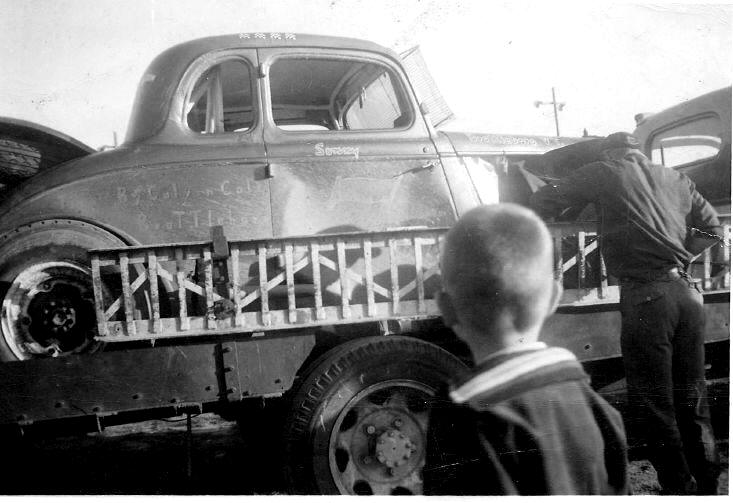
Courtesy of Ken Robertson
Because
Brattleboro, Millers Falls, Keene, and possibly Claremont were part of the
influential Triangle Racing Association, Rabideau was exposed to a number of
future racing legends such as Rene Charland, Ed Patnode, Buddy Krebs, Pappy
Forsyth, Ray Brown, and dozens more. The car the brother built sported the
number 7. It is arguable whether the brother [sorry, I have no name] ever drove
the thing himself. Sonny claimed their first #7 was an ill – handling nightmare.
Rabideau would go on to make his name with Frank “Stroker” Smith, whose little cutdown #311 was a very dominant car. First, he would graduate from the family 7 to the North Hampton, MA – based DN3 of the Cazchini family which was so potent that it was often just called “The Beast”. Rabideau and Smith would be champions at a highly – competitive Claremont track and would cross over into Vermont to claim some titles over there, as well – at Fairmont Speedway and at the Vermont State Fairgrounds in Rutland.

Courtesy of Crystal Snape
Sonny [2nd
from right] stands with the Cazchini brothers at Cheshire with potent DN3. Below
- The winning team of Sonny and Stroker Smith.
Cavalcade of Auto Racing Photo
Towards the end of his career, into the overhead V-8 era, Rabideau would still drive for Smith, and also spent a ;lot of time Leo Vallancourt's 333 cars. Rabideau would concentrate mostly on Claremont and the newly – built Devil's Bowl Speedway, which replaced the Fairmont track he had done so well on. The last time I saw Sonny was was recalling memories with Don Rounds, whom he raced against mostly back in the Triangle Racing Association years before each went to establish careers in different circles.
Our second star managed to win a NASCAR National Sportsman Co – Championship – still early in his career. Dick Nephew, the stocky Frenchman from near the border in northern New York ran his own red #6's for some of the best ryears of his career; but, he started out with a low – cost hobby #7 coupe in his earliest days at Airborne Park Speedway in South Plattsburgh, NY. Likely with help from Ben Nephew, an uncle, Dick drive this #7 at Airborne against some future greats such as Charlie Trombley, Buck Holliday, Bob Bruno, Ernie Reid, and others in Airborne's very important second season of 1955. Although he was running in the next class up, Bill Wimble [who would be Nephew's co – champion in the 1961 sportsman national points chase] did race there in that same year.
Bob Mackey Photo via John Rock
A young Dick Nephew stands
with his car 7 at Airborne in 1955.
Below – Dick, with the George Palmetier and the 6 7/8, numbered
after George's considerable head size.
Bob Mackey Photo via John Rock
It is very likely Nephew, a heavy equipment operator, may have also run at the rough and tumble Fort Covington Speedway, on Akwesasne Mohawk land right on the Canadian border with that first car. Photographs show the Nephew 7 running on Airborne in 1955 shots. Dick would then drive for prominent owner George Palmetier and his 6 7/8 car. Nephew would not only get used to racing a faster car, but he would be able to race in Airborne's lead class with that car.
Turning the hard – drinking Palmetier and his car over to Jackie Peterson, Nephew would begin to build and run his own cars by the late 1950's. Always red and usually Chevies, the Nephew 6, with loyal sponsors like Vic Jubert's Meats and the City Taxi of Shadow Broderick, would show strongly, finishing way up in the NASCAR National Sportsman standings in 1960 before tying with Wimble in 1961.
Courtesy of Wes Moody
The Nephew 1961 national
champion car, sitting at home during
a rare moment when it was not being raced. Below – Unlike his
co-champion, Wimble did not start with a car numbered 7.
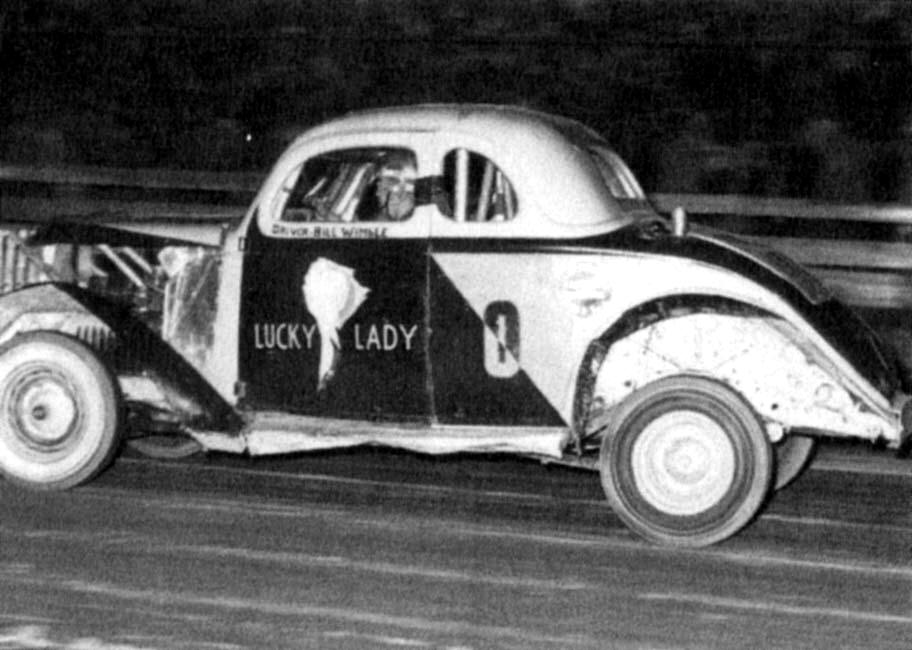
Wimble Collection
Nephew was fond of talking about how strenuous it was to chase those points that year; Wimble has concurred. Sadly, both men are gone now. Each insisted that NASCAR manipulated strings to give the other a leg up on that frantic race in 1961. One convenient place for each to pick up easy NASCAR points was a track I attended -Otter Creek Speedway in Vergennes, VT. There weren't a ,lot of top NASCAR sportsman teams running there – and, in fact, the powerful overhead coupes would run in with local flathead and six cylinder hobby cars, still getting the same points.
While he actually began way back with the roadsters in Central New York, Ken Meahl's stock car career seems to have started with another humble – looking coupe numbered 7. Meahl, who ran the dangerous roadsters at early tracks like Seneca Falls, NY, had a career in New York modified that could stand alone in its merits towards halls of fame consideration. And yet, he best know by a lot of racing fans for two sort of odd things.
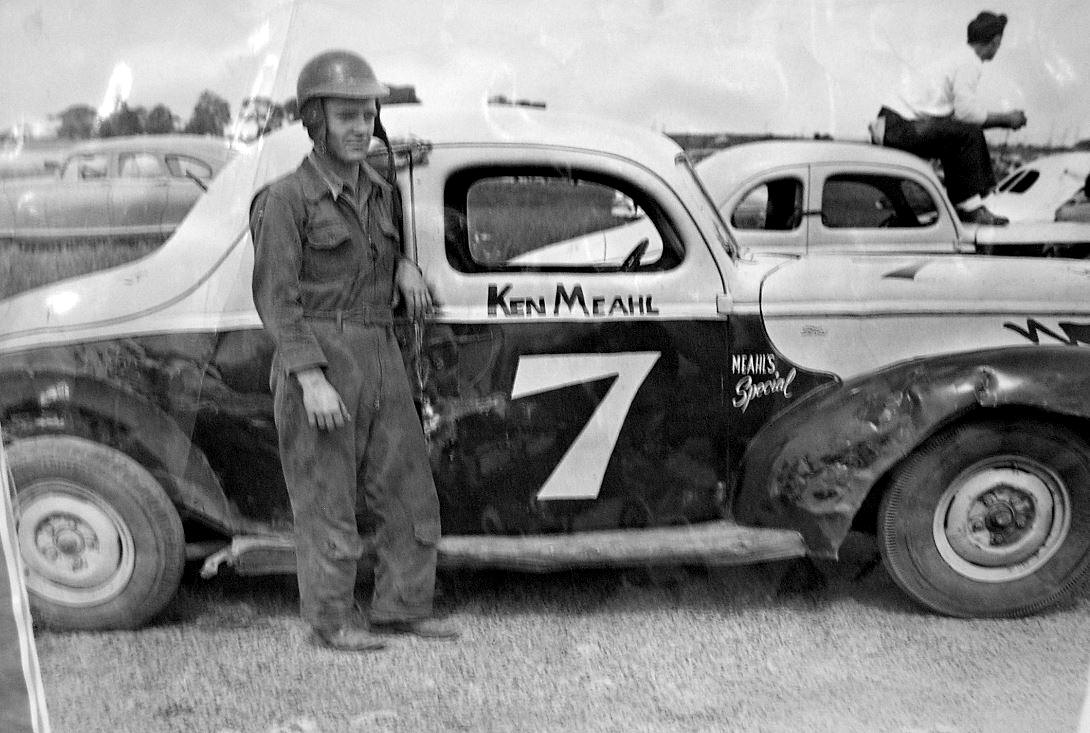
From DIRT HOF Display
Already a veteran, Ken Meahl
stands with his first stock car. Below – Meahl raced at Seneca Falls Speedway in
a roadster before stock cars.
Courtesy of David DeLange
When a very young Jerry Cook began constructing nice race cars out in his native Lockport, NY, he was far too young to drive them. It soon fell to fellow Lockport area citizen Ken Meahl [by then a veteran driver] to drive the first Cook cars. The earliest Cook cars stayed pretty close to home, although that did not preclude him and Meahl from places like Monroe County Speedway near Rochester.
In 1963, at that aforementioned rural track in Vergennes, VT, a program of NASCAR sportsman cars was shaping up for one of their Sunday afternoon shows. In 1961 and still into that 1963 season, the Chris Drellos 111 driven by Ken Shoemaker was the alpha male at Otter Creek. On a Sunday early in the season, an unknown grey primer 1936 Chevy coupe was hauled down the hill to the pit area at Otter Creek. No one was that impressed, as the track's fields were often supplemented by second – tier New York teams and local sportsman cars which often came in primer and never returned.
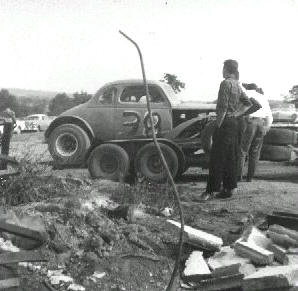
Ladabouche Photo
The mysterious primered 38 car
steals off with a big upset
win over Ken Shoemaker at Otter Creek in 1963. Below-
This is an earlier Meahl/Cook collaboration. Jerry, Ken, Gene Hare, and
dad, Ronald Cook are in the shot.
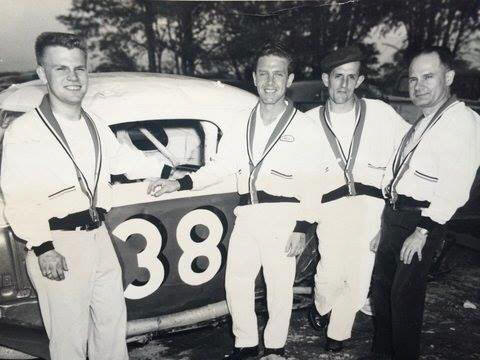
Courtesy of Cook Friends
However, this was Ken Meahl and the brand new, state – of – the – art NASCAR sportsman that Cook had built. They blew away the field and disappeared off into the sunset. The car would be seen, in red and white, at Fonda and other tracks first driven by Meahl and later, by Cook. Meahl would then leave the team and begin driving very fast white #28 coupes for Red Snediker of Rochester. Meahl's second “claim to fame” came in 1963 or 4 when he took a tumble over thirty feet in the air at Fonda and made the all – time worst wrecks list in the Fonda book.
Meahl would race, at first with his humble #7 coupe out west in New York, move through the Cook era, on to the Snediker era, and on to race a number of other fast cars before retiring. A photo of his #7 jalopy, at the time of my induction into Weedsport, rated a prominent spot on an easel at the DIRT museum, where I was able to get a snapshot of it. A winner of numerous features and awards, and a survivor of some wicked crashes, Ken Meahl made the number 7 proud.
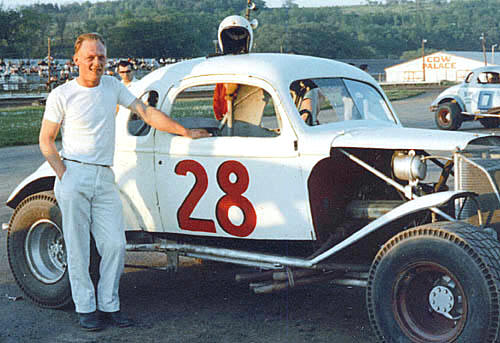
Russ Bergh Photo Ladabouche Collection
Ken, in the potent Snediker
28. Below – Ken is led off in a daze
after taking electrical wires off the stands 30 feet up at Fonda.
Russ Bergh Photo Feuz Collection
Another big name in New York racing most likely began with another humble, low cost #7 coupe. Bill Rafter, of Clarence Center, NY, is forever and firmly linked with car owner Gil Bruss and his #22's. But Rafter appeared in recent photos on the internet with a car 7 that looked pretty much like the same class and the same general racing era as the above - mentioned cars and drivers. Rafter had begun racing at the age of 17 and is shown with his car 7 at age 22; but, it appears that he likely had started with that number.
At some point in his 20's, Rafter caught the eye of Gil Bruss, whose fast #22 coupe propelled the two to notoriety particularly in Central and Western New York racing. Rafter is seen at most of the major post season racing events in that time [such as Langhorne and Trenton] and has been extremely successful in Bruss cars right up to when modifieds began to go through the post – coupe evolutions. Bruss would also field cars for such as former Indy star Jim Hurtubise.

Stock Car Racers' Reunion
Bill Rafter with what might be
his first car. Love the dice. Below-
Rafter with his trademark Gil Bruss 22 in the 1960's.
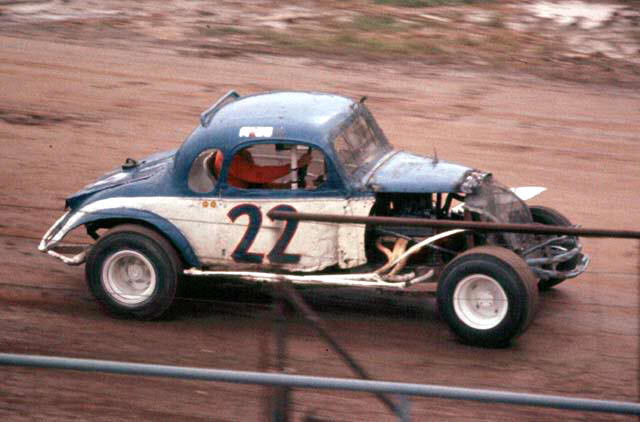
Stock Car Racers' Reunion
The final star comes from a considerably different background and did not achieve his fame in coupes, or in dirt – style New York and New Hampshire racing. Harmon “Beaver” Dragon, of Milton, VT grew up as a young man who was truly raised by the village. Not having his father around, the mechanically – savvy Dragon was guided along by local garage owners Rex Hewey and Johnny Bourgeois [actually business competitors.
From Hewey, Dragon got the lifelong nickname Beaver, and from Bourgeois – the chance to drive a race car. In keeping with the whole village thing, Bourgeois, Keith Lombard, and a number of Milton men helped get Beaver a race car for the nearby track in Malletts Bay. Friend and Milton schoolmate Marcel Brisson – headed for military service – afforded his 1938 Buick coupe. The car was outfitted with a cheated – up Buick engine and given the number 7.

Courtesy of the Bourgeois Family
Beaver, with Johnny Bourgeois,
Keith Lombard and another man
with the original Buick coupe around 1959 in Milton. Below – The 7,
two years later, in a heat race with only hobby cars at Otter Creek
Speedway near Vergennes, VT.
Courtesy of Cho Lee
Beaver won the first race he ever entered in that car. They were running a liquid oin the ghas used in blasting, and the car had to be stalled out to stop running. After running at Malletts Bay with the car there was a hiatus when there were no real tracks nearby to run at. He appeared [where I saw him for the first time] at the previously – mentioned Otter Creek Speedway in 1961 as “Herman Dragon” and they were thrown in with the other hobby cars and the overhead V-8 sportsman cars. Little did I know that, almost fifty years later, I would write that man's biography.
Beaver would race mostly on pavement and mostly with late model cars of one sort or another. He did spend some time running cars for Ray and Mike Richards on the dirt at Devil's Bowl between 1967 and 1970. He would be a NASCAR late model series champion and would hold various titles while winning a lot of features – particularly at Catamount and at Airborne. He did not care much for racing at Thunder Road, but he did so consistently.
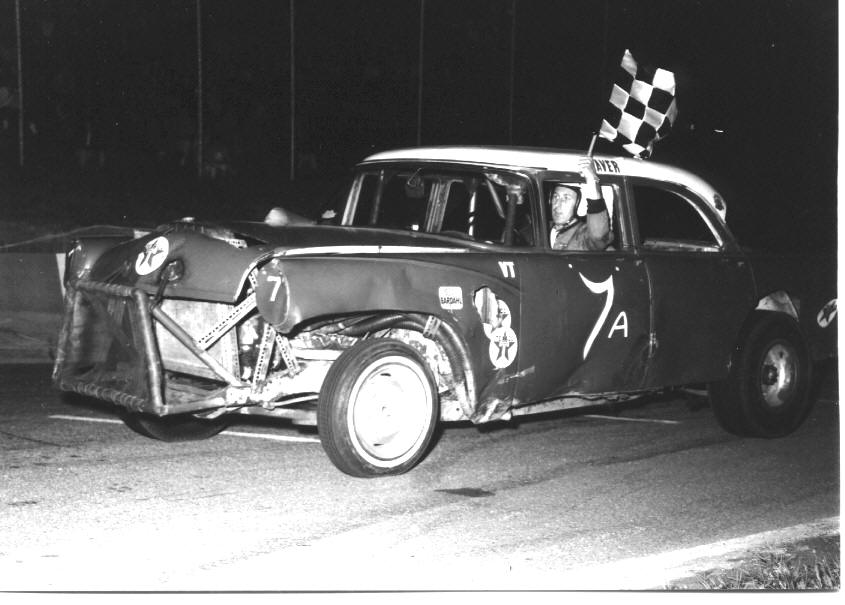
Dragon Family Collection
This tricked out Ford was the
first in a long line of late model cars
in the career of Beaver Dragon. Below – Beaver did keep in touch with
the coupe and dirt world for a while up to about 1971. This one would
soon be redone with the familiar 75 of Ray Richards.
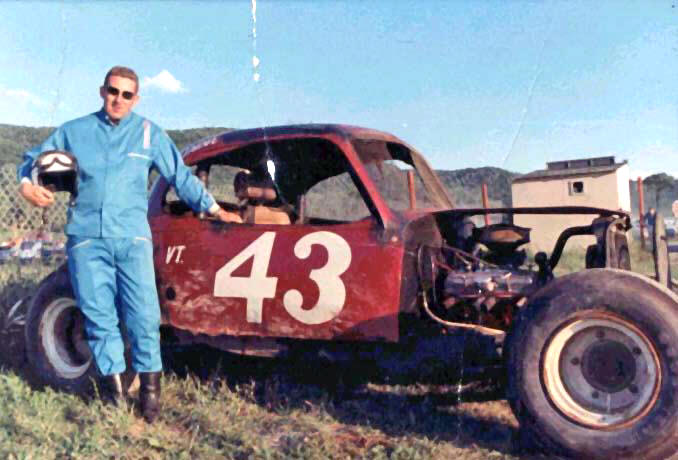
Dragon Family Collection
Milton people recently took delight in seeing rare photos of that Beaver Dragon Buick coupe #7. Many had never seen it or any photos given their younger ages and the fact the photos remained in the Bourgeois photo album until given to me around 2005. Beaver often used a number 7 or a variation of it. His last prominent 7 ride was that of Littleton, NH's Quint Boisvert – the famous Black Magic Nova.
Ladabouche Collection
I am sure there at least as many more legendary drivers who began their careers with a humble #7 coupe. These were the ones who came to me readily.
Please email me if you have any photos to lend me or information and corrections I could benefit from. Please do not submit anything you are not willing to allow me to use on my website - and thanks. Email is: wladabou@comcast.net . For those who still don’t like computers - my regular address is: Bill Ladabouche, 23 York Street, Swanton, Vermont 05488.
AS ALWAYS, DON’T FORGET TO CHECK OUT THE
REST OF MY WEBSITE
www.catamountstadium.com
Return to the Main Page
Return to the Main News Page
Return to the All Links Page
Return to the Weekly Blog Links Page